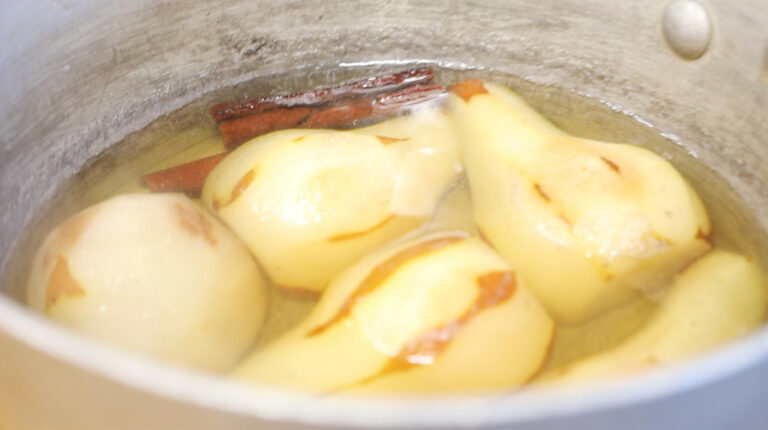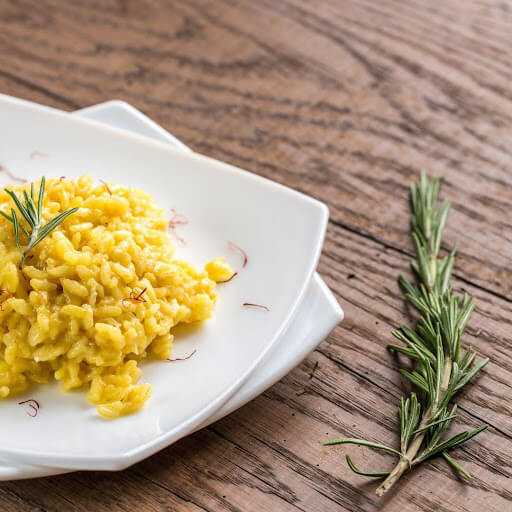This poached pears recipe is awesome! We make them in the restaurant all the time, and sell them on pizzas, subs, and salads. We soak them in a simple syrup for half an hour to give them the amazing, cinnamon flavor that everyone loves. We’re going to show you how we make them, so you can try them for yourself at home.
Remember when you were a kid and you’d get home from school on a crisp autumn day? The temperature was just starting to drop, school just started back up for the year, football was on in the back, and you were always in a really great mood?
That’s what this recipe smells like.
Every single time I smell these delicious poached pears, I’m taken right back to my childhood; with my house being filled with the fragrant aroma of early to late fall.
The secret? It’s all in the cinnamon sticks.
Not granulated cinnamon, big old-fashioned cinnamon sticks that you used to see at your grandmother’s house. They absorb into every bit of the mixture to fill your house with that sweet, cider-like scent.
And guess what? They taste exactly how they smell.
When paired with a gentle simmer, the honey, sugar and cinnamon sticks make a thick syrup and seeps into every bit of the pears to make them soft, chewy, and bursting with flavor.
This is a great option for your next dinner party. There’s something about poaching pears that adds a sophisticated touch to every meal. Maybe it’s in the hints of spice, or perhaps the luscious syrup that the pears spend a lot of time in. There’s nothing as yummy as a nice, tender pear.
You’ll want to quit your job and work on a farm selling cider donuts and poached pears by the jar.
Until you save up the money to do so, I’m gonna show you one of my favorite ways to poach these so they turn out amazing.
*Don’t feel like reading? We’ve got you covered. Watch our YouTube tutorial below!*
What You Need to Poach the Perfect Pear
Pears: We use bosc pears, but any kind of pear will work just as well.
Sugar: Use granulated sugar instead of powdered sugar.
Water: A lot of people like to simmer their pears in a white wine and water mixture, but we’re just using water today. Measure out one quart for this.
Honey: Get a jar of some nice, raw honey from your local farm stand; it makes a huge difference.
Cinnamon sticks: You can get a container of these at your local supermarket. Use one cinnamon stick, or use a bunch. It’s entirely up to you.
Vanilla bean (optional): We didn’t use a vanilla bean in our recipe, but if you had one, it would be a delicious addition. A dash of vanilla extract would work too.

How to Choose the Best Pears to Poach
Choosing the right pear for poaching is essential to achieving the best flavor and texture. Here are some guidelines to help you choose the best pears to poach:
Variety: Certain varieties are better suited for poaching than others. Bosc and Anjou pears are popular choices for poaching due to their firm flesh that holds up well during the cooking process. Bartlett pears can also be poached, but they are softer and may become mushy if overcooked.
Ripeness: Look for pears that are just barely ripe. They should be firm to touch but not hard. Overripe pears can become mushy and lose their shape during poaching, while underripe pears won’t absorb the flavors of the poaching liquid as well.
Size: Try to choose pears that are all roughly the same size. This will ensure that they cook at the same rate, and all the pears will be ready at the same time.
Shape: Choose pears with a symmetrical shape for the best presentation. They should have a well-defined “pear” shape, with a bulbous bottom and a narrower top.
Skin Condition: The skin should be free of cuts, bruises, and blemishes. While you’ll likely peel the pears before poaching, damage to the skin can indicate problems with the fruit inside.
Smell: A ripe pear should have a fresh and fragrant smell. If there’s no aroma, the pear is probably not ripe enough. If the smell is too strong or fermented, the pear may be overripe.
Remember that the quality of your ingredients greatly affects the quality of your final dish. By starting with the best pears, you’ll increase your chances of creating a delicious poached pear dessert.
How We Poach Our Pears
This recipe is so much easier than you would think.
Step 1: Use a vegetable peeler to peel each of your whole pears. Cut them in half, cutting the stems off and taking the seeds out. Make sure you use a sharp knife, as they can be hard and tough to cut.

Step 2: Put your water, sugar, and honey into a large saucepan and heat until sugar dissolves, stirring occasionally in a circular motion. It’s important to heat this on low to medium heat, as we aren’t boiling the water.
Step 3: Once the sugar dissolves, place pear halves and cinnamon sticks into the water. Make sure the surface of the liquid is low enough so that a tiny bit of the pears remain uncovered. Simmer on medium-low heat for 20-25 minutes.

Step 4: When 25 minutes have passed, test out your pears. Try sticking a knife into them. You’ll know they’re done when the knife easily slides in and out of them. Take them out with a slotted spoon and place on a paper towel for a few minutes to cool off.

Step 5: Cut the pears into little strips, toss them into a recipe, or eat them by the handful. Whatever it is, we won’t judge. Enjoy!
Alternative Flavors and Variations
Experimenting with different flavors and variations can add a refreshing twist to the traditional poached pears recipe, allowing you to cater to a variety of palates and occasions.
Other non-alcoholic liquids for poaching
While water mixed with sugar serves as a simple and effective poaching liquid, there are many other non-alcoholic options you can consider to enhance the flavor of your poached pears.
Fruit juices: Apple, pear, or even orange juice can add a fruity zest to your dessert.
Herbal tea: Using a strong brew of herbal tea like chamomile or mint can infuse your pears with a subtle hint of herbs.
Non-alcoholic wines: These can mimic the taste of traditional poached pears without the alcohol content.
Coffee: For a richer, more robust flavor, a strong black coffee could be used, giving your dessert a unique twist.
Different spices and sweeteners that can be used
Spices and sweeteners can greatly influence the final taste of your poached pears. Here are a few suggestions:
Spices: Cinnamon, star anise, nutmeg, and vanilla beans can add a warm and comforting flavor.
Sweeteners: Besides regular sugar, you could try honey, maple syrup, or agave nectar for a natural sweetness. Brown sugar can also be used for a more caramel-like taste.
Suggestions for seasonal or thematic variations
Winter variation: Add warming spices like cloves, cinnamon, and ginger. Serve with a dollop of cream and a sprinkle of crushed gingerbread cookies for a festive touch.
Autumn variation: Use apple cider for poaching and include a touch of pumpkin spice. Serve with a scoop of vanilla ice cream and caramel drizzle.
Spring variation: Poach in a light floral tea like chamomile or hibiscus, and garnish with edible spring flowers.
Summer variation: Use a light citrus juice for poaching and serve chilled with a side of lemon sorbet or fresh berries.
With these variations and alternatives, you can enjoy poached pears all year round, each time with a new, delicious twist.
Health Benefits of Poached Pears
Poached pears are a nutritious dessert option that provide various health benefits, including:
Rich in Fiber: Pears are high in dietary fiber, which aids in digestion, helps to control blood sugar levels, and supports a healthy heart by reducing “bad” LDL cholesterol.
Good Source of Vitamin C: Pears are a good source of vitamin C, a powerful antioxidant that boosts the immune system and aids in the repair and growth of all bodily tissues. It also plays a crucial role in the formation of collagen, which helps keep our skin healthy.
Low in Calories: Poached pears, particularly when made without adding a lot of sugar, are a lower-calorie dessert option. This makes them a great choice for those who are watching their caloric intake or trying to lose weight.
Hydrating: Because poaching involves simmering the fruit in liquid, poached pears can be a more hydrating dessert option.
Antioxidants: Depending on the spices and sweeteners used, you can increase the antioxidant value of your dessert. For instance, cinnamon, cloves, and star anise are rich in antioxidants which help protect your body from damage by free radicals.
Healthier Sweetness: Using natural sweeteners like honey or maple syrup instead of refined sugar offers a more complex flavor profile and some additional nutrients.
Versatility for Dietary Needs: Poached pears are naturally gluten-free, and depending on the sweetener used, they can be made vegan, making them suitable for a variety of dietary restrictions.
Remember, while poached pears do have several health benefits, they should be consumed as part of a balanced diet. Excess consumption of any dessert, even a relatively healthy one, should be avoided.
Poached Pears Recipe FAQs
Q: Can I use any type of pear for poaching?
A: Yes, you can technically use any type of pear. However, certain varieties hold up better during the cooking process. Bosc and Anjou pears are common choices because of their firmness and sweetness.
Q: Can I reuse the poaching liquid?
A: Yes, the poaching liquid can be reused. You can even reduce it into a syrup for further use as a topping for the pears or other desserts. Just ensure you store it properly in the fridge.
Q: How do I know when the pears are done?
A: The pears are done when they are tender but not falling apart. A good way to test this is by piercing them with a fork or knife. If the utensil goes in and comes out easily, your pears are ready.
Q: Can I serve poached pears warm or do they have to be chilled?
A: Poached pears can be served either warm or chilled based on personal preference. They are often chilled and served as a refreshing dessert, but they can be just as delicious when served warm, especially during colder months.
Q: Can I poach other fruits the same way?
A: Yes, you can use the same poaching method for many other fruits like apples, peaches, plums, or apricots. The key is to adjust the cooking time according to the hardness of the fruit.
Q: How long can I store poached pears in the refrigerator?
A: Poached pears can be stored in an airtight container in the refrigerator for up to five days. Ensure that they are completely cool before storing.
Q: Is it necessary to peel the pears before poaching?
A: It’s recommended to peel the pears before poaching so they can better absorb the flavors from the poaching liquid. However, if you prefer, you can leave the skin on. The skin will darken during poaching, which can give an interesting visual contrast.
Q: Should I serve these hot or cold?
A: You can serve these warm, cold, or at room temperature, depending on how you’re serving them. They taste delicious however you serve them, but if you’re serving them with a dessert, make sure they’re warm.
Q: How do I reheat poached pears?
A: If you know you’re going to want to save and reheat some, here’s the best way to do it. Save the “fruit juice” from the hot poaching liquid. Heat all of the ingredients together in a saucepan when ready to eat. They’ll be delicious!
Q: Can I freeze these?
A: They can become a bit soggy when defrosted, so we don’t recommend doing this.
What to make with poached pears
Prosciutto and pear pizza: Make a roman pizza bianca and top it with garlic cream sauce, mozzarella cheese, figs, prosciutto, arugula, balsamic glaze, and your poached pears. The sweetness of the pears goes nicely with the saltiness of the cheese and prosciutto. It’ll be delicious!
Pig and fig sub: Try your hand at our classic recipe by putting poached pears, prosciutto, gorgonzola, fig jam, mixed greens and balsamic vinaigrette on a sub roll. Nice and fancy!
Poached pears à la mode: Impress your family and take dessert up a notch with this simple dessert. Serve warm on top of vanilla ice cream, sprinkling with brown sugar and whipped cream at the end if you’d like.
Give This Poached Pears Recipe a Try
There you have it—our simple, no-wine-needed poached pears recipe that’s packed with flavor and perfect for salads, desserts, pizzas, or just snacking on its own. It’s easy, affordable, and guaranteed to impress.
Got your own spin on it? Drop your ideas or questions in the comments—we’d love to hear from you! And if you’d rather skip the cooking and just enjoy delicious food, visit our store here: https://mortadellaheadstore.com
Print
easy poached pears recipe without white wine
5 Stars 4 Stars 3 Stars 2 Stars 1 Star
4.6 from 5 reviews
- Author: Mortadella Head
- Total Time: 30 minutes
- Yield: 2 1x
Ingredients
3 pears
1 cup sugar
1/4 cup honey
2 or 3 cinnamon sticks
1 quart of water
1 vanilla bean (optional)
Instructions
- Peel & slice your pears in half, getting rid of the seeds as you slice them.
- Heat up sugar, water and honey in a pan until the sugar dissolves, stirring occasionally.
- Place pears, cinnamon sticks and vanilla bean in the pan, leaving some breathing room at the top, and let simmer on low heat for 25 minutes.
- Pears are ready when they’re soft and a knife can easily go in and out.
- Enjoy!
- Prep Time: 5
- Cook Time: 25











12 Responses
I tried this the other day, and loved it! The cinnamon stick adds a nice dimension.
It definitely does! I’m glad you liked it.
I tried this method and added the vanilla bean like you suggested. It came out amazing! Will definitely be making this one more often.
I’m glad you liked it! Thanks for your review.
Leftovers for breakfast with cottage cheese and fruit. So good!
I was looking for a healthy recipe using the healthy pear fruit since we are trying to reduce the amount of sugar in our diet. Let me tell you — this ain’t it! So, this has now become my cheat day dessert recipe. It is fantastic. The recipe as written is very good but it lends itself to experimentation. This time, I used the suggestions to try different spices (my combo was cinnamon sticks, whole cloves, whole juniper berries, whole allspice berries, star anise) and fruit juice (the juice of one small orange and the zest taken off in strips). I didn’t have a vanilla bean so I had to go with the extract. I reduced the liquid a bit and refrigerated the pears with liquid in the refrigerator for several hours. Good thing cheat day comes once a week…
I’m sure the recipe is great, love poached pears, but gods you NEED to learn how to peel better. If you were using a knife and were worried about taking too much flesh off I would understand a bit, but there’s no excuse if you have a vegetable peeler. It’s a simple thing.
Thank you for posting this. Funny I had a craving for poached pears earlier. Though I do not think I have ever had them. Pretty cosmic. Lol
Lol it must have been a sign then 😀 I hope you liked our recipe!
Can the pears be cut up and then poached? Would your cooking time need to be altered. It is easier to eat for some folks rather than risk the pear flying across the table. 🙂
Hi Nel. Yes, you can cut them in smaller pieces and poach them. The cooking time will be a little lower – try sticking a knife into them every once in a while. You’ll know they’re done when the knife easily slides in and out of them.
Just made this. Fantastic served over vanilla icecream. Added the vanilla bean as suggested as well as a clove, and two allspice berries. Tasting this gave me inspiration for my next mead: spiced pear(pyment). I am gonna save the syrup for my must. Reduce the white sugar and raise the honey. Thanks for the inspiration!